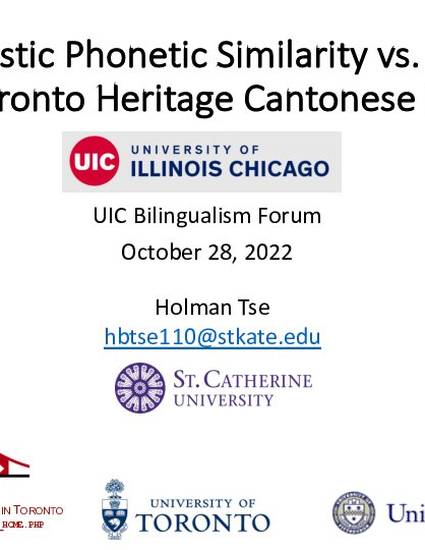
Presentation
Cross-linguistic Phonetic Similarity vs. Phonemic Transfer in Toronto Heritage Cantonese High Vowels
University of Illinois Chicago Bilingualism Forum (UIC BilForum)
(2022)
Abstract
Studies of heritage bilingual speaker vowel production have generally shown maintenance of both language internal and cross-linguistic distinctions (see Polinsky, 2018 for an extensive review). One notable exception comes from Tse’s (2022) study of Toronto Heritage Cantonese showing evidence of merger between /y/ and /u/ (ex: [kyn35] ‘roll’ vs. [kun35] ‘public building’) for a subgroup of speakers. Given widespread English-dominance within this group, a plausible explanation is cross-linguistic phonemic transfer from Toronto English, which lacks a similar phonological contrast and contains only /u/ (henceforth UW to distinguish from Cantonese /u/), which has been shown to be phonetically fronted as is the case in many North American English dialects (Boberg, 2011). The evidence for English influence, however, was largely indirect and based on group-level comparisons rather than on individual speaker patterns of how Cantonese and English interact with each other in the same acoustic space. In this presentation, cross-linguistic influence is addressed by comparing acoustic measurements of both the Cantonese and English spoken by the same individual speakers. The specific research questions addressed are as follows:
Q1) Is English UW produced more similarly to /y/ or /u/ in terms of F2?
Q2) How does /y/~/u/ merger interact with English UW?
Data comes from the Heritage Language Variation and Change in Toronto (HLVC) Project corpus (Nagy, 2011), which includes sociolinguistic interviews (spontaneous speech recordings). Participants were told that the interviews were to be primarily in Cantonese, but they were allowed to code-switch into English as often as was natural. This made it possible to analyze both English and Cantonese vowels coming from the same individual speakers. The current study includes a total of 10 speakers amounting to a total of 291 tokens of /y/, 105 tokens of /u/, and 175 tokens of UW. F2 was measured for each token. To address Q1, regression models were run for each individual speaker with F2 as the dependent variable and vowel category (/y/ vs. UW or /u/ vs. UW) as the independent variable. For Q2, Pillai Scores (Nycz & Hall-Lew, 2015) were calculated for each individual speaker as a measurement of acoustic distance between /y/ and /u/ with lower scores indicating more merged pronunciations.
Results from the F2 analysis show that all 10 speakers produced a significant difference between /u/ and UW with UW having higher F2 (more fronting) than /u/. For the difference between /y/ and UW, the results were more variable. Six out of the 10 speakers produced a significant distinction while four did not. For speakers that produced a significant distinction, /y/ had higher F2 (more fronting) than UW. The Pillai Score analysis shows that the four speakers that did not produce a significant distinction between /y/ and UW were also speakers with lower Pillai Scores. Thus, speakers with less /y/~/u/ distinction also show cross-linguistic merger between /y/ and UW, but not between /u/ and UW.
Overall, these results show cross-linguistic influence to be mediated more strongly by cross-linguistic phonetic similarity than by direct transfer of phonemic categories. Since UW is phonetically fronted, English-dominant speakers may perceive more similarity between UW and /y/ than between UW and /u/. This could then in turn motivate cross-linguistic merger in production between UW and /y/ while /u/ remains relatively stable. Cantonese /y/~/u/ merger could, thus, be an epiphenomenal consequence of /y/~UW cross-linguistic phonetic merger rather than a result of transfer of phonemic categories. If phonemic transfer were involved, we would expect to also see /u/-UW merger, but that is not what was observed.
Keywords
- bilingualism,
- heritage languages,
- Chinese - Yue,
- sound change,
- sociophonetics,
- vowels
Disciplines
Publication Date
October 28, 2022
Location
Chicago, IL
Citation Information
Holman Tse. "Cross-linguistic Phonetic Similarity vs. Phonemic Transfer in Toronto Heritage Cantonese High Vowels" University of Illinois Chicago Bilingualism Forum (UIC BilForum) (2022) Available at: http://works.bepress.com/holman-tse/20/
Creative Commons License

This work is licensed under a Creative Commons CC_BY International License.
